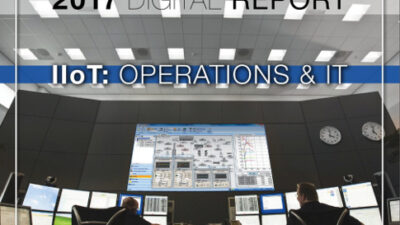Advances in vibration analysis have lead to modern condition monitoring systems that can significantly improve plant production. Adding industrial wireless technologies can result in lower costs and better reliability. In one plant, installing a system with fiber optics would have taken six months; wireless Ethernet monitoring took three weeks.
Advances in vibration analysis have lead to modern condition monitoring systems that can significantly improve plant production. Adding industrial wireless technologies can result in lower costs and better reliability. In one plant, installing a system with fiber optics would have taken six months; wireless Ethernet monitoring took three weeks.
Mechanical failure of motors, drives and other vital electromechanical equipment are among the most common reasons for production stoppages. Fortunately, recent advancements in vibration monitoring and data analysis have lead to condition monitoring systems that can accurately detect a problem before failure, thus reducing costly machine shutdowns and maximizing production output. These systems are installed on the monitored equipment and are typically networked back to a central computer for data analysis and alarm annunciation. Because the machines may be in remote locations where network infrastructure is not available, or on moving platforms where hardwired network connectivity is not practical, wireless communications is a networking alternative that offers installation cost savings, quicker deployment and even improved reliability in certain situations.
Cost, payback
For many industries, the purchase of a condition monitoring system is easily justified with a simple return-on-investment (ROI) calculation. For a relatively nominal cost, vital machines may be retrofitted with condition monitoring to reduce operating failures. However, there are additional costs to consider when network infrastructure is unavailable or impractical. This extra expense can include fiber optic cable installation, conduit engineering and installation, trenching between buildings, leasing phone lines for remote sites, and installation of festooning or slip rings for moving equipment. These additional costs may push the ROI out beyond what management will accept.
If the monitored machine is in a remote location within the factory where network infrastructure is not available, cable installation is necessary. Cable installation costs in an industrial plant can vary greatly based upon the type of plant and physical configurations. Average cable installation in a chemical plant is $40 per foot ($120 per meter), while cable installation within a nuclear power plant can be as much as $2,000 per ft ($6,000 per m), studies show. The actual cable cost depends on machine location relative to existing network infrastructure, type of cable needed (such as fiber optic), conduit engineering (if needed), labor cost rates, and trenching costs, if required.
If the machine is in a remote location several miles (kilometers) or more away, then leasing phone lines for communications is required. Leased phone line costs usually include an initial activation/installation fee and monthly fee based upon speed of service. Since vibration monitoring is continuous and typically data intensive, the phone line service must support a high enough speed for continuous monitoring. Phone line service to remote sites, such as pump stations, are also prone to communication failures due to poor line quality and reliability may be of concern. Wireless cellular services are sometimes an option for remote sites, but are subject to service availability and limited in speed. Cellular data subscription costs may also be expensive.
If the machine is on a moving platform (such as an overhead crane, transfer car or conveyor system), then connecting the condition monitoring system to the plant network is a particular challenge. Depending on the speed and distance that the platform travels, traditional cabling methods, such as festooning may be possible. However, festooning is subject to wear and tear, and is a reliability concern as cables may break. For spinning platforms, slip rings with Ethernet support are available, but are expensive and require periodic maintenance. Some machines may move so fast that the only practical communication method is wireless RF communications.
Given the challenges of networking condition monitoring systems, wireless communications offer lower installation costs (shorten ROI time), eliminate phone lines and remotely monitor machines that were not practical before. But wireless technologies and equipment vary widely in performance and reliability in industrial installation. Designing a successful wireless network requires an examination of current wireless usage, RF paths and environmental challenges of the industrial plant.
Condition monitoring integration
Most condition monitoring systems have an Ethernet communication option for network connectivity. Ethernet is the most easily adaptable interface for wireless if two considerations are observed: data rate (bandwidth) and data latency.
These considerations especially come into play when multiple remote machines are monitored. It is important to design an RF network that effectively reaches all remote sites while maintaining adequate data rates. If the number of remote machines is high, then it may be best to install separate RF systems to maximize the performance of each.
| A condition monitoring system for fans in a power plant cooling tower was easy to install. Wireless Ethernet cost significantly less and could be installed in three weeks instead of six months, compared to fiber optic cable. |
Machine locations and building structures will determine antenna placement and may be another reason to consider multiple RF systems. Many industrial systems also support packet repeating to aid in RF signal propagation while also creating self-healing meshes.
Finally, it is very important for the wireless equipment to be designed for industrial installations. Key specifications to examine are RF power output (higher is usually better), operating temperature, built-in diagnostics, hazardous certifications (if they are necessary) and, perhaps most importantly, the support staff’s level of industrial networking knowledge.
Security, application examples
Frequency hopping offers the best chance for successful data transmission, because the transmitter will send the packet over and over again using different channels until an acknowledgement is received. The disadvantage of frequency hopping is that it is slower than direct sequence and has longer data latency. Also, frequency hopping modems are proprietary, meaning that each manufacturer uses its own technique and vendor X will usually not communicate with vendor Y. This can be desirable for industrial systems for two reasons: security and isolation from the wireless IT system.
Several applications where wireless condition monitoring is particularly effective include monitoring of pumps in wastewater treatment plants, drives used on oil/gas drilling rigs, drives on assembly lines in automotive plants and overhead cranes in hot metal mills.
One particularly interesting application is power plant cooling fan monitoring. A coal-fired power generation plant wanted to monitor its cooling fans. These were located at the base of cooling towers, mounted in very harsh areas where hot steam is always present. When a fan would fail, the tower had to be shutdown to allow a technician to repair it, thus reducing the power output of the plant, sometimes during peak demand periods. By installing the condition monitoring system, the plant would be able to schedule fan repair during non-peak shutdowns.
The condition monitoring system was relatively easy to install, except that the towers lacked Ethernet network infrastructure. The cost of pulling fiber optic cable was estimated more than $100,000 and would take more than six months to install. The power plant investigated using wireless Ethernet and discovered that it would only cost a small fraction of fiber and could be installed within three weeks. The installation went very smoothly and the system has been reliably operating more than five years.
| Author Information |
| Jim Ralston, with more than 10 years’ experience with industrial wireless systems, is currently a wireless sales engineer for ProSoft Technology Inc., . Reach him at [email protected] . |


